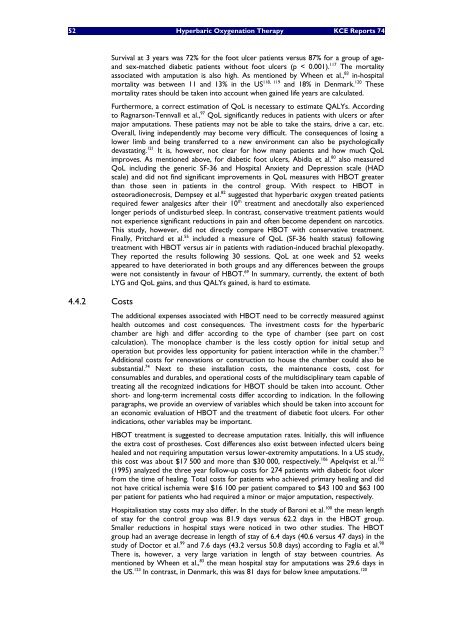Hyperbare Zuurstoftherapie: Rapid Assessment - KCE
Hyperbare Zuurstoftherapie: Rapid Assessment - KCE
Hyperbare Zuurstoftherapie: Rapid Assessment - KCE
You also want an ePaper? Increase the reach of your titles
YUMPU automatically turns print PDFs into web optimized ePapers that Google loves.
52 Hyperbaric Oxygenation Therapy <strong>KCE</strong> Reports 74<br />
4.4.2 Costs<br />
Survival at 3 years was 72% for the foot ulcer patients versus 87% for a group of ageand<br />
sex-matched diabetic patients without foot ulcers (p < 0.001). 117 The mortality<br />
associated with amputation is also high. As mentioned by Wheen et al., 83 in-hospital<br />
mortality was between 11 and 13% in the US 118, 119 and 18% in Denmark. 120 These<br />
mortality rates should be taken into account when gained life years are calculated.<br />
Furthermore, a correct estimation of QoL is necessary to estimate QALYs. According<br />
to Ragnarson-Tennvall et al., 97 QoL significantly reduces in patients with ulcers or after<br />
major amputations. These patients may not be able to take the stairs, drive a car, etc.<br />
Overall, living independently may become very difficult. The consequences of losing a<br />
lower limb and being transferred to a new environment can also be psychologically<br />
devastating. 121 It is, however, not clear for how many patients and how much QoL<br />
improves. As mentioned above, for diabetic foot ulcers, Abidia et al. 80 also measured<br />
QoL including the generic SF-36 and Hospital Anxiety and Depression scale (HAD<br />
scale) and did not find significant improvements in QoL measures with HBOT greater<br />
than those seen in patients in the control group. With respect to HBOT in<br />
osteoradionecrosis, Dempsey et al. 82 suggested that hyperbaric oxygen treated patients<br />
required fewer analgesics after their 10 th treatment and anecdotally also experienced<br />
longer periods of undisturbed sleep. In contrast, conservative treatment patients would<br />
not experience significant reductions in pain and often become dependent on narcotics.<br />
This study, however, did not directly compare HBOT with conservative treatment.<br />
Finally, Pritchard et al. 55 included a measure of QoL (SF-36 health status) following<br />
treatment with HBOT versus air in patients with radiation-induced brachial plexopathy.<br />
They reported the results following 30 sessions. QoL at one week and 52 weeks<br />
appeared to have deteriorated in both groups and any differences between the groups<br />
were not consistently in favour of HBOT. 69 In summary, currently, the extent of both<br />
LYG and QoL gains, and thus QALYs gained, is hard to estimate.<br />
The additional expenses associated with HBOT need to be correctly measured against<br />
health outcomes and cost consequences. The investment costs for the hyperbaric<br />
chamber are high and differ according to the type of chamber (see part on cost<br />
calculation). The monoplace chamber is the less costly option for initial setup and<br />
operation but provides less opportunity for patient interaction while in the chamber. 73<br />
Additional costs for renovations or construction to house the chamber could also be<br />
substantial. 74 Next to these installation costs, the maintenance costs, cost for<br />
consumables and durables, and operational costs of the multidisciplinary team capable of<br />
treating all the recognized indications for HBOT should be taken into account. Other<br />
short- and long-term incremental costs differ according to indication. In the following<br />
paragraphs, we provide an overview of variables which should be taken into account for<br />
an economic evaluation of HBOT and the treatment of diabetic foot ulcers. For other<br />
indications, other variables may be important.<br />
HBOT treatment is suggested to decrease amputation rates. Initially, this will influence<br />
the extra cost of prostheses. Cost differences also exist between infected ulcers being<br />
healed and not requiring amputation versus lower-extremity amputations. In a US study,<br />
this cost was about $17 500 and more than $30 000, respectively. 106 Apelqvist et al. 122<br />
(1995) analyzed the three year follow-up costs for 274 patients with diabetic foot ulcer<br />
from the time of healing. Total costs for patients who achieved primary healing and did<br />
not have critical ischemia were $16 100 per patient compared to $43 100 and $63 100<br />
per patient for patients who had required a minor or major amputation, respectively.<br />
Hospitalisation stay costs may also differ. In the study of Baroni et al. 100 the mean length<br />
of stay for the control group was 81.9 days versus 62.2 days in the HBOT group.<br />
Smaller reductions in hospital stays were noticed in two other studies. The HBOT<br />
group had an average decrease in length of stay of 6.4 days (40.6 versus 47 days) in the<br />
study of Doctor et al. 99 and 7.6 days (43.2 versus 50.8 days) according to Faglia et al. 98<br />
There is, however, a very large variation in length of stay between countries. As<br />
mentioned by Wheen et al., 83 the mean hospital stay for amputations was 29.6 days in<br />
the US. 123 In contrast, in Denmark, this was 81 days for below knee amputations. 120

















